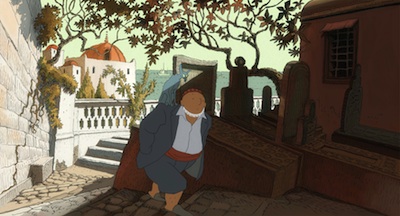By Michael Fox , Special to JTNews
Animated movies, even more than live-action films, invite us to lose ourselves in a wholly invented world.
French-Jewish filmmaker Joann Sfar and Antoine Delesvaux’s deliciously delirious feature, “The Rabbi’s Cat,” is set in a real time and place — Algeria in the 1930s, where Sephardic Jews and Arabs had a long history of co-existence — yet evokes the anything-can-happen quality of a fairy tale.
Adapted from Sfar’s best-selling graphic novel and its sequels, “The Rabbi’s Cat” marries his witty, untethered animation to a great, bouncy soundtrack. It’s a deeply pleasurable experience, not least because it doesn’t push and strain for deep meanings.
The episodic, digressive film may not build to a moral, but if there is a takeaway it’s that we should aspire to tolerance rather than dogmatism.
“The Rabbi’s Cat,” which won France’s César Award for Best Animated Feature, screens in the Seattle Jewish Film Festival. A few sexual references and a couple of brief sequences of violence perhaps make the subtitled film inappropriate for children under 12.
Imbued with the surreal illogic of a dream, “The Rabbi’s Cat” is utterly unique, even if the hand-drawn visuals may remind some viewers of Marc Chagall’s child-like exuberance and vibrant palette.
A widowed, middle-aged sage enjoys a tranquil, affable life with his curvaceous teenage daughter, Zlabya, who’s more interested in boys and gossip than the words of the prophets, and his cat, who accompanies him on his rounds to cafes, shul, etc.
Complying with the immutable laws of nature, one day the cat kills and devours Zlabya’s pet parrot. In a decidedly unnatural turn of events, the cat acquires the power of speech.
His first utterance is a denial that he’s responsible for the bird’s demise, a lie that provokes the rabbi into a Talmud lesson. To our amazement, the acerbic and impolitic feline is fully capable of debating issues of faith and Jewish law.
Needless to say, the rabbi can hold his own, while generally maintaining his good humor. Overall, he’s a model of equanimity, which proves essential when the duo embark on an expedition across the continent.
The impetus is the arrival of a Russian Jewish painter who’s searching for a lost tribe and a rumored city in Ethiopia. The helpful rabbi and curious cat enlist a wealthy entrepreneur and an Arab sheikh in the artist’s quest, and the quintet set off on a meandering trek through the African desert.
The film unfolds in a romantic and exotic setting, but it doesn’t romanticize or exoticize human nature. Neither colorblind nor politically correct, “The Rabbi’s Cat” revels in mocking those who only see religion, race and color.
For instance, after a memorably threatening encounter with a Muslim hardliner, the sheikh remarks, “It’s a pity He lets so many fools speak in His name.”
Bigotry is not limited to one religion, however. The mysterious city, when they finally reach it, turns out to be populated by black Jews who can’t conceive of white co-religionists and pull out their spears. Their murderous aims come to naught, fortunately.
The droll fatalism that runs through “The Rabbi’s Cat” is just one among many delights. But it’s the most consistent indicator, ultimately, of the film’s Jewish source and sensibility.
“The Rabbi’s Cat” is in French with English subtitles. (unrated, 89 minutes)
